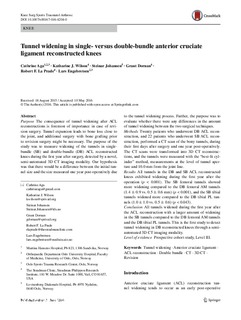| dc.contributor.author | Aga, Cathrine | |
| dc.contributor.author | Wilson, Katharine J. | |
| dc.contributor.author | Johansen, Steinar | |
| dc.contributor.author | Dornan, Grant | |
| dc.contributor.author | LaPrade, Robert F. | |
| dc.contributor.author | Engebretsen, Lars | |
| dc.date.accessioned | 2016-09-19T13:33:10Z | |
| dc.date.available | 2016-09-19T13:33:10Z | |
| dc.date.issued | 2016-06-21 | |
| dc.identifier.citation | Knee Surgery, Sports Traumatology, Arthroscopy. 2016, 1-12 | nb_NO |
| dc.identifier.uri | http://hdl.handle.net/11250/2408377 | |
| dc.description | © 2016 The Author(s). This is an Open Access article. | |
| dc.description.abstract | Purpose:
The consequence of tunnel widening after ACL reconstructions is foremost of importance in case of revision surgery. Tunnel expansion leads to bone loss close to the joint, and additional surgery with bone grafting prior to revision surgery might be necessary. The purpose of the study was to measure widening of the tunnels in single-bundle (SB) and double-bundle (DB) ACL reconstructed knees during the first year after surgery, detected by a novel, semi-automated 3D CT imaging modality. Our hypothesis was that there would be a difference between the initial tunnel size and the size measured one year post-operatively due to the tunnel widening process. Further, the purpose was to evaluate whether there were any differences in the amount of tunnel widening between the two surgical techniques.
Methods:
Twenty patients who underwent DB ACL reconstruction, and 22 patients who underwent SB ACL reconstruction, performed a CT scan of the bony tunnels, during their first days after surgery and one year post-operatively. The CT scans were transformed into 3D CT reconstructions, and the tunnels were measured with the “best-fit cylinder” method, measurements at the level of tunnel aperture and 10.0 mm from the joint line.
Results:
All tunnels in the DB and SB ACL reconstructed knees exhibited widening during the first year after the operation (p < 0.001). The SB femoral tunnels showed more widening compared to the DB femoral AM tunnels (1.4 ± 0.9 vs. 0.5 ± 0.6 mm) (p < 0.001), and the SB tibial tunnels widened more compared to the DB tibial PL tunnels (1.0 ± 1.0 vs. 0.5 ± 0.6) (p < 0.043).
Conclusion:
All tunnels widened during the first year after the ACL reconstruction with a larger amount of widening in the SB tunnels compared to the DB femoral AM tunnels and the DB tibial PL tunnels. This is the first study to detect tunnel widening in DB reconstructed knees through a semi-automated 3D CT imaging modality.
Level of evidence:
Prospective cohort study, Level III. | nb_NO |
| dc.language.iso | eng | nb_NO |
| dc.publisher | Springer | nb_NO |
| dc.subject | tunnel widening | nb_NO |
| dc.subject | anterior cruciate ligament | nb_NO |
| dc.subject | ACL reconstruction | nb_NO |
| dc.subject | double bundle | nb_NO |
| dc.subject | CT | nb_NO |
| dc.subject | 3D CT | nb_NO |
| dc.subject | Revision | nb_NO |
| dc.title | Tunnel widening in single- versus double-bundle anterior cruciate ligament reconstructed knees | nb_NO |
| dc.type | Journal article | nb_NO |
| dc.type | Peer reviewed | nb_NO |
| dc.subject.nsi | VDP::Medical disciplines: 700 | nb_NO |
| dc.identifier.doi | 10.1007/s00167-016-4204-0 | |
| dc.description.localcode | Seksjon for idrettsmedisinske fag / Department of Sports Medicine | nb_NO |
